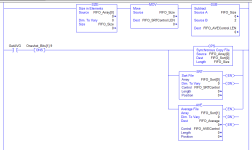fishin_fl
Member
I am using a distance laser to bring in an analog value. I have converted the value to inches and filling an array using FIFO using RSLogix 5000.
I know you can average an array with the AVE instruction, but I am wanting to discard the outliers(extremes).
Can someone assist me in completing this task?
I know you can average an array with the AVE instruction, but I am wanting to discard the outliers(extremes).
Can someone assist me in completing this task?
Last edited:





